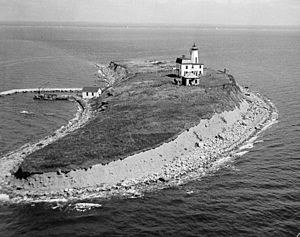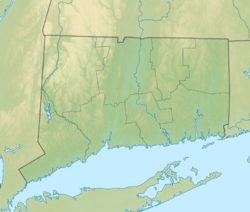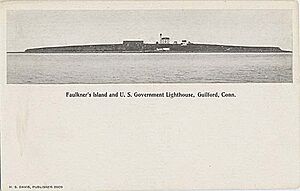Falkner Island Light facts for kids
 |
|
| View of Falkner Island and Light | |
|
|
|
| Coordinates | 41°12′43″N 72°39′12″W / 41.21194°N 72.65333°W |
|---|---|
| Year first constructed | 1802 |
| Automated | 1978 |
| Foundation | fieldstone basement |
| Construction | brownstone with brick lining tower |
| Tower shape | octagonal tower with balcony and lantern |
| Markings / pattern | White tower, red lantern |
| Height | 46 ft (14 m) |
| Focal height | 94 feet (29 m) |
| Original lens | 9 lamps, 16" reflectors (1840) |
| Current lens | VLB-44 |
| Range | 13 nautical miles (24 km; 15 mi) |
| Characteristic | Fl W 10s. |
| Admiralty number | J0762 |
| ARLHS number | USA-282 |
| USCG number | 1-21170 |
The Falkner Island Light, also called the Faulkner Island Lighthouse, is a historic lighthouse in Connecticut, United States. It stands on Falkner Island, which is located off Guilford Harbor in Long Island Sound. President Thomas Jefferson ordered its construction in 1802.
The lighthouse has had three different keeper's houses over the years. The first house was built in 1802. It was rebuilt in 1851 and then again in 1871. The 1871 house was damaged by fire in 1976. After this, the Coast Guard fixed the lighthouse and made it automatic in 1978.
Since 1991, a group of volunteers called the Faulkner's Light Brigade has worked to restore and protect the lighthouse. They finished a big restoration project in March 2011. You cannot visit Falkner Island and the lighthouse from May to August. This is because roseate terns, an endangered bird species, nest there during these months. The Falkner Island Lighthouse is the second oldest lighthouse still standing in Connecticut. It is listed on the National Register of Historic Places.
Contents
Discovering Falkner Island
Falkner Island is a small, crescent-shaped island. It is located about three and a half miles offshore from Guilford, Connecticut. Over the years, the island has had several different owners.
In the 1600s, a person named Andrew Leete owned the island. Later, in 1715, Caleb and Ebenezer Stone bought it. The Stone family owned the island until 1801. In 1800, Noah Stone sold it to a distant relative, Medad Stone, for $158.34.
On May 12, 1801, Medad Stone sold the island to the United States government for $325. Historians believe that Medad Stone and the government were already talking about the sale. The U.S. Congress had set aside $6,000 for the lighthouse in March 1801. This was even before the government officially bought the land.
Building the Lighthouse
President Thomas Jefferson ordered the Falkner Island Lighthouse to be built in 1802. Abisha Woodward was the person who built and finished the lighthouse that same year. Woodward also built other lighthouses, like the New London Harbor Light in 1801 and the Black Rock Harbor Light in 1808.
The U.S. government reported that the Falkner Island Lighthouse cost $5,977.62 to build. The tower is 46 ft (14 m) tall and has eight sides. It was made from brownstone and had a brick lining inside. Originally, it had a spiral wooden staircase that went up to the lantern room. This outdoor staircase was a very unique feature of the Falkner Island Light.
The first light used twelve lamps and reflectors on two stacked tables. In 1840, this system was replaced. The new lantern used nine lamps and sixteen-inch reflectors and cost $2,842.00. During a big renovation in 1871, a 33 ft (10 m) cast iron spiral staircase was put inside the tower.
Keeper's Houses
The first keeper's house had eight rooms. It started to fall apart and was rebuilt in 1858. The rebuilt house was one-and-a-half stories tall. It had three bedrooms, a kitchen, a dining room, and a sitting room. However, the building quality was not very good. Snow could even get inside the house during winter through gaps in the walls and roof.
In 1871, the United States Coast Guard rebuilt it again. This time, it was a three-story house. This house stood until March 15, 1976, when it was destroyed by fire. The fire also caused some damage to the lighthouse tower next to it. In 2002, a publication called The Octagon described the keeper's house as a two-story house with eleven rooms.
Lighthouse Service and Upgrades
During the War of 1812, British soldiers landed on the island. They told the keeper's wife, Thankful Stone, that they would not harm them if the light stayed on. Later, the keeper, Solomon Stone, had to turn off the light. This was an order from the New London customs inspector. The British then threatened to blow up the lighthouse. Because of this, Stone got an order to relight the lighthouse.
In 1856, the light was improved. It changed from twelve lamps to a fourth-order Fresnel lens. The new light would shine steadily with a flash every two seconds. Around 1976, a GE 1000-watt bulb was used. After the fire, the lighthouse was repaired and made automatic in 1978. A modern light replaced the old Fresnel lens. Today, the lighthouse uses a VRB-25 lens.
In 1988, the lighthouse switched to solar power. The light now flashes white every ten seconds. It continues to help boats navigate safely near the Intracoastal Waterway.
Fog Signals
Falkner Island Light was used for experiments with fog signals. This happened in 1865 and again in 1902. In 1865, Joseph Henry from the Smithsonian Institution tested how far bells and whistles could be heard. He was the Chairman of the Lighthouse Board.
In 1879, a steam fog whistle was installed. This cost $5,000. In 1902, an air siren was put in place. It was powered by two 16½ horsepower engines. This siren was part of an experiment to see how well sound could travel through the air. In 1934, a Leslie-Tyfon trumpet was installed.
Lighthouse Restoration Efforts
After the 1976 fire, more damage occurred. The lighthouse windows were bricked up, and a steel door was installed. A group of volunteers called "Faulkner's Light Brigade" formed in 1991. They work to restore and protect the lighthouse.
In 1997, Walter Sedovic was chosen to lead the restoration. This work was finished in 1999. It included painting the inside and outside of the lighthouse. They also replaced the door and added a new entry deck made of Pau Lope wood.
Protecting from Erosion
The lighthouse has been at risk from erosion for many years. Erosion is when land slowly wears away, often by water. In the 1930s, a breakwater was built to protect the boat landing area from erosion.
In 1996, two groups, the Connecticut Trust for Historic Preservation and the National Trust for Historic Preservation, helped get money for a big project. This project, costing $4.5 million, was for erosion control. The funds were approved in 1998. This happened with help from Connecticut Senators Joseph Lieberman and Christopher Dodd, and Representative Rosa DeLauro.
In 2001, a stone wall was built, and a buffer zone was created. The next part of the project will involve building a protective stone barrier on the south side of the island.
Recent Repairs
The 33-foot cast iron spiral staircase from 1871 was repaired and restored. This work cost $15,724. Conservation Services did the work. They found and saved the original numbers on the stairs.
In October 2010, a major restoration project began. The tower and lantern were repainted. New ventilated steel doors were installed. The original weathervane was fixed, and a 12-pane window on the west wall was repaired. The work was paused in December 2010 due to bad weather. It was completed in March 2011. The total cost for this project was $121,000.
Why Falkner Island Light is Important
The Falkner Island Light is the second oldest lighthouse still standing in Connecticut. It was added to the National Register of Historic Places on May 29, 1990. The Town of Guilford celebrated the lighthouse's 200th birthday. They declared September 7, 2002, as "Faulkner's Island Light Day."
Falkner Island is also home to one of the world's largest breeding groups of the endangered roseate tern. These birds nest on the island from May through August. To protect these birds, access to Falkner Island and the lighthouse is restricted during their nesting season.
- Lighthouse Friends says the tower is 40 ft (12 m) tall. However, other official publications state the tower is 46 ft (14 m) tall.





